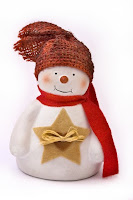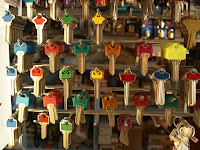- Pull out all of my receipts for the year, set aside the ones for taxes and keep those that were for large purchases or electronics. The rest get shredded.
- Start new files for all of my regular and monthly bills; take out the previous year and include the necessary ones in the tax file.
- Sort through my ideas file and the one marked "items of interest" to see which still apply and determine what to keep or give up.
- Discard/shred any files that no longer need to exist and replace and label-well worn folders to keep everything looking neat.
- Investment statements go into a binder and stored in archival files in storage areas.
Wednesday, December 29, 2010
Ring in a More Organized New Year
Friday, December 10, 2010
Organized Holiday Decorating
I'm not an expert decorator myself and in fact don't have a very large stash, so I turned to our Organizing Boston resident expert, Kate Altieri, for some organized holiday decorating tips. Kate loves to decorate for the holidays and has a self-proclaimed rather large festive supply. Here's what she suggests to keep holiday decorating fun and spirited rather than cluttered and chaotic:
- As you unpack, take note of what needs better or new containers; purchase these as you do your holiday shopping.
- Donate or throw away unused or broken items. Gather unused holiday cards from previous years; make a complete set for donation.
- Take inventory of gift wrap, tags, ribbon, etc. before you purchase more. Be sure to have paper and gift boxes the size to fit odd shaped or large items.
- If you have space, save some boxes from catalog/on-line shopping for shipping gifts or storing your decorations.
- Before shopping for decorations, make a list of areas indoors and outdoors that you want to include. Choose a theme to keep you on track.
- Remember to have proper hooks, ties and mounting tape on hand for attaching decorations inside and outside. This will reduce damage to walls and woodwork after they are taken down.
- Consider how you will store certain items off-season (i.e. large and delicate items) so that they will last from year to year.
- Take pictures of the current decorations while they are up so that you can repeat or change things for next year; especially outdoor window boxes, containers, and lights.
- As you put things away, be sure they are clearly labeled to eliminate blind searching next year.
Friday, December 03, 2010
Stay Organized During Holiday Shopping Season
Tuesday, November 30, 2010
Get Organized to Get In Shape
- People often hold onto clutter for emotional reasons, just like extra weight. Addressing the emotional background may be key to making progress on either front.
- You have to decide that you are ready to free yourself from your excess stuff, just like you have to be ready to lose the weight. Professionals or family and friends can help support you, but it has to come from within.
- Drastic approaches to de-cluttering often fail in the long term, just like weight loss. Slow and steady changes definitely win the race.
Friday, November 19, 2010
What to Do With Your Kids' Creations
1) Hanging Art Gallery - Using a curtain rod with clips or a simple wire/cord attached to the wall, you can create a gallery space where favorites are displayed and then switched out for newer works periodically. The selection and easy switch process can be done by or with your children, allowing them to take ownership of the gallery. And if you still want to save one or all of the pieces that come down, you can keep a special box for this or follow up with the binder or photo book ideas below. Here are some great examples of galleries from Ohdeedoh.com and MakesandTakes.com. If you don't have a curtain rod with clips, you can simply use ribbon or string to tie clips or clothes pins to the rod. You can see my friend Melissa's simple and cute creation for her daughter's room in the picture above.
2) Framed Gallery - Along the same lines as the hanging art gallery, you can use frames that are easy to switch pieces in and out of, such as those shown by MakesandTakes.com or Unclutterer.com. You can also use simple acrylic frames from an office supply store - either free-standing or magnetic. And speaking of magnetic, another great idea for a gallery pictured in the Makes and Takes post is to paint a wall section with magnetic paint - I love this one too because it would be super easy to switch and rearrange differently-sized works of art.
3) Special Selections Book - Another idea especially good for 8.5 x 11 or smaller works of art is a simple binder with sheet protectors. You can use a fun, decorative binder, such as those available at Target, rather than an office-supply version. This is an easy way to preserve items for each child and can also be combined with special school projects for a year-long memory book.
4) Photo Book - Another great way to preserve more in less space and with a "professional" look and feel is to take photographs of the works of art and create a photo book using any of the online photo sites (i.e. Shutterfly, Snapfish, Kodak Gallery). This is especially good for 3-dimensional works that are harder to display on a wall. Talk about a great way to make an artist feel special! This could be your first step or a follow up step from the gallery ideas above. Simply take photos of your rotating gallery art (to be included in a photo book) before it's taken down to make room for the next round.
Bottom Line: Don't let your child's artwork become a source of clutter and stress. Try out the above ideas for enjoying and treasuring their creations - a win-win situation for you, your artist and your home!
Photo Credit: Thanks to Melissa for sharing her art gallery inspiration!
Monday, November 15, 2010
NBC's Back to Basics Series
Friday, October 29, 2010
Tis the Season...
 Well, almost. The weather has returned to being somewhat seasonal (after an October heat-wave!) and November is just around the corner. That means that before we know it, it'll be time to start preparing for the holidays, which often means holiday shopping and gift-giving. To help us get our gift ideas going, The Container Store has just come out with its stocking stuffer guide filled with useful* gadgets for everyone on your list.
Well, almost. The weather has returned to being somewhat seasonal (after an October heat-wave!) and November is just around the corner. That means that before we know it, it'll be time to start preparing for the holidays, which often means holiday shopping and gift-giving. To help us get our gift ideas going, The Container Store has just come out with its stocking stuffer guide filled with useful* gadgets for everyone on your list.Wednesday, October 27, 2010
Organizing Makes the Evening News
 I must say I was quite surprised to turn on the evening news with Katie Couric last night and hear a feature story about simplifying your life with input from organizing expert Peter Walsh. Americans are beginning to fight back against the overstuffed way of life we have gotten ourselves into.
I must say I was quite surprised to turn on the evening news with Katie Couric last night and hear a feature story about simplifying your life with input from organizing expert Peter Walsh. Americans are beginning to fight back against the overstuffed way of life we have gotten ourselves into. Monday, October 25, 2010
Organization All Around Us
 This weekend, I was reminded that we can find examples of organization all around us. Some of these examples are the big ideas we take for granted, such as waiting in line at a store or parking lots with neatly painted spaces. But I was taking note of smaller examples, including the labeled 'Field Monitor' headphones the referee was wearing while reviewing a play during the Patriots game and the shoe store clerk noting how important it was for them to put the pens back in the pen holder at the counter, so they can find one quickly when it gets busy.
This weekend, I was reminded that we can find examples of organization all around us. Some of these examples are the big ideas we take for granted, such as waiting in line at a store or parking lots with neatly painted spaces. But I was taking note of smaller examples, including the labeled 'Field Monitor' headphones the referee was wearing while reviewing a play during the Patriots game and the shoe store clerk noting how important it was for them to put the pens back in the pen holder at the counter, so they can find one quickly when it gets busy. Wednesday, October 20, 2010
Warm up Your Closet for Fall
 If you haven't noticed, we're definitely into fall - the leaves are turning, the temperatures are getting chilly and it's already snowed in Vermont! Unless you own very little clothing or have a very large closet, you probably need to store off-season clothing in a less-accessible location - such as under the bed or in the basement or attic. If you haven't done so already, it's time to make sure the seasons have changed in your closet as well as outside. Here's a simple how-to guide to walk you through this switch.
If you haven't noticed, we're definitely into fall - the leaves are turning, the temperatures are getting chilly and it's already snowed in Vermont! Unless you own very little clothing or have a very large closet, you probably need to store off-season clothing in a less-accessible location - such as under the bed or in the basement or attic. If you haven't done so already, it's time to make sure the seasons have changed in your closet as well as outside. Here's a simple how-to guide to walk you through this switch.Monday, October 18, 2010
Top Ten Time Management Tips

And we're back! The last few weeks have been a great example that sometimes life just gets in the way of getting everything done...even for professional organizers! But the key to making progress is to get back on the horse and keep going. On that note, this seems like a perfect time to review the ten time management tips we've highlighted over the last several months. I can't believe it, but the holiday season is just around the corner, so what better time to reclaim some precious time and figure out how to get things done without feeling crazy!
So if you've been following us, this will be review, and if you've missed the tips, here they are in one place. Check out the full post for each tip for more explanation and inspiration. And if you're feeling overwhelmed, remember to start small - incorporate one tip at a time. The beauty is, it'll get easier as you go!
Top Ten Time Management Tips
I'm focusing on #1, 4, 5, and 9...how about you?
Bottom Line: Fall is the perfect time to turn over a new leaf and try out or recommit (that would be me) to these simple tips for streamlining your life and routine so you have time to get to (almost) everything you want to!
Monday, September 27, 2010
Information Overload

Time-Saving Tip #10: Downsize Your Inbox - limit your incoming email and mail to items you need or want to receive.
Let’s face it, there’s only so much information we can take in and process. With so much information out there, you will do yourself a huge favor to put some limits on what you let into your mailbox or inbox...especially if you’re someone who feels obligated to read potentially useful information...you know who you are. We all inevitably end up on mailing lists we don’t want to be on or that seemed like a good idea at the time. Next time you get something that falls into that category, go ahead - click the unsubscribe link! If you don’t love it and read it right away, it’s probably not worth your time.
When it comes to snail mail, if you find yourself spending lots of time getting rid of junk mail (or worse, not getting rid of it), it might be worth your time to spend a few minutes getting yourself off the major mailing lists that are contributing to your mail clutter. For more information on reducing junk mail, check out our post Less Paper, Please on our other blog, Get Organized and Go Green. Also take a look at your subscriptions - if you don’t have time to read and enjoy all the magazines, papers and newsletters you get, you are wasting money and paper. Consider paring down what you get delivered - you can always access information on-line or add back in others down the road. And if you find yourself backed up - either with paper or electronic FYI material - cut yourself some slack, declare information bankruptcy, recycle or delete what you haven’t gotten to and start fresh with the new material. Spring gardening tips won’t do you much good in the middle of fall anyway!
Bottom Line: Save time and money by limiting your mail and email to what matters most and cutting out the rest!
Friday, September 17, 2010
Sarah Buckwalter on TLC's Hoarding: Buried Alive
Monday, September 13, 2010
Just Get It Done!
Time-Saving Tip #9: If it’s only going to take a few minutes, just do it!
Sometimes we waste a lot of time thinking about what to do next - this applies at home and at work. Most of the time, we would feel a lot better (and get more done), if we just channelled our inner Nike and ‘just did it.’ Getting things done tends to build momentum. So open the pile of mail, take the trash out, put the donation items in your car, make that phone call. You get the idea. Those small household and work tasks can weigh us down when they start to multiply. Keep them at bay by keeping up with them. Try to schedule yourself 15-30 minutes daily just to tackle some of those little unfinished projects before they turn into permanent fixtures on your unfinished project list. I’ll admit, I’ve got a few of those on my list, so let’s all start a productive week and just get it done...whatever it is!
Bottom line: Tackle those small projects before they add up with just 15 minutes a day of ‘getting it done.’
Wednesday, September 08, 2010
Fall into Organization with a ‘Playbook’ for Your Team
Time-Saving Tip #8: Streamline your routine with a simple household binder.
All you need is a small binder- use a spare one you have around or try these eco-friendly binders from greenroom, available at Target - some sheet protectors or a 3-hole punch, and some dividers. Simply hole-punch (or slip into sheet protectors) all those important papers, schedules, pieces of information that might otherwise get lost in a pile on the kitchen counter. This might include extracurricular or daycare schedules, important contact info, including babysitters, tutors, and coaches, upcoming events, and more. You can even step it up a notch and include a family chore chart, a master calendar or extra features like lunch-box ideas so these tasks can easily be shared among family members or helpers. Use the dividers to separate types of information or create a section for each family member - you can customize your binder to meet your family’s needs.
Get everyone involved in the binder - gathering information, deciding on what to call it, and most importantly, where it will live. If everyone in your house knows about the binder, you stand a fighting chance of being on the same page. Now wouldn’t that be nice?!
Bottom Line: Create a simple household binder as a place to store and organize your family’s activities and you’ll have your playbook prepped for a winning team!
Friday, September 03, 2010
Organizing Obstacles
The 6 major clutter culprits reviewed are:
1) Guilt - “My best friend gave this to me, so I feel guilty getting rid of it.”
2) Perceived Value - “I am planning to sell this someday.”
3) Saving for the Future - “I might need this someday.”
4) Donation Delay - “I want to make sure this will go to someone who really needs it.”
5) Out of Site, Out of Mind - “If I put this away, I’ll never remember to do it.”
6) Inertia - “I want to get organized, but I just don’t know where to begin.”
Check out the article for some great ideas for overcoming these barriers. I see all of these obstacles when I work with people, but I think number 3 is a big culprit. Accumulating stuff is so easy and it can be really challenging for people to get rid of items that they perceive to be useful and that they might need someday. This might be back-up items of things you already own (i.e. extra towels) or items for an activity that you used to do or would like to do (i.e. craft supplies).
If you find yourself saving things for the future, and we all do, ask yourself these questions:
1) Could somebody else use this more than I can right now?
2) Do I value a clean, clutter-free space now more than the potential future use of this item?
Bottom Line: Doing a little soul-searching to figure out the root causes of your clutter will help you turn over a new leaf for a clutter-free future.







